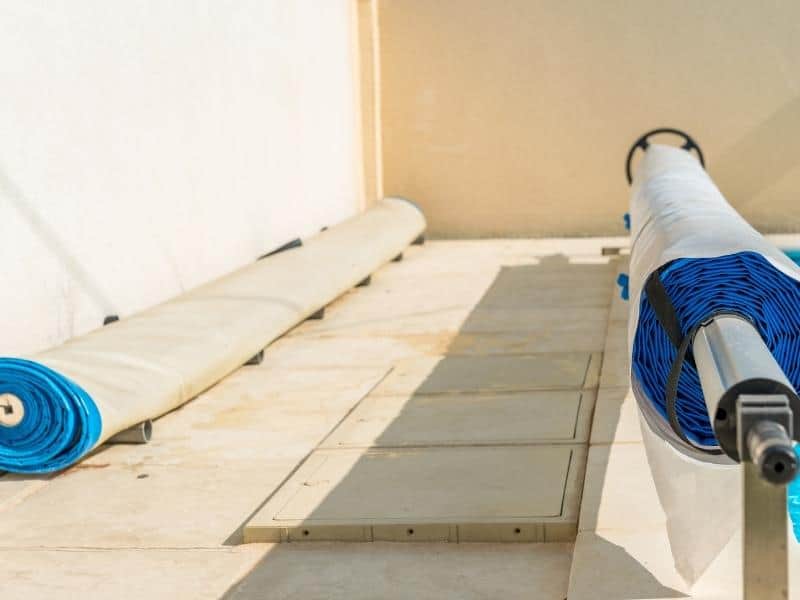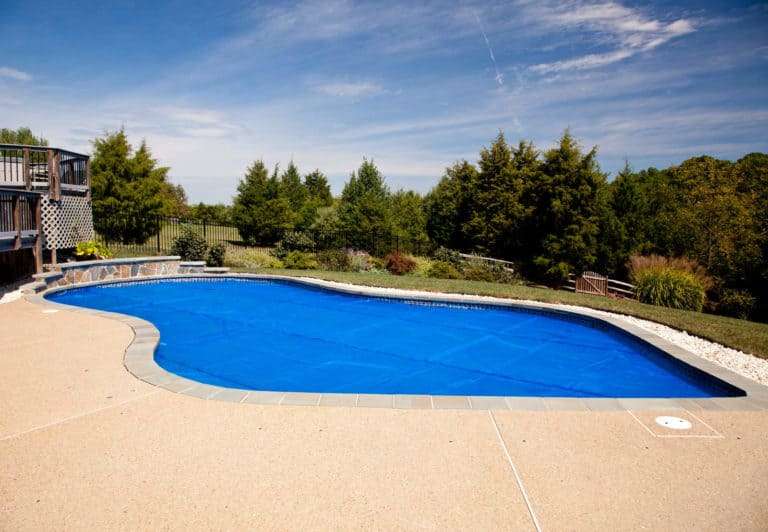Although the most efficient way of heating a pool is to use a pool pump heater, this is both expensive and bad for the environment. Solar pool covers prevent a cheaper and eco-friendly method of heating pools, but do they work?
Key points about solar covers:
- How effective are solar covers at heating?
- Do solar covers have other benefits?
- The different covers available and how they compare.
- How expensive are solar covers?
- What is the longevity of solar pool covers?
- Dangers associated with solar covers?
Solar pool covers effectively warm swimming pools by converting solar radiation into usable heat and acting as a cover to stop heat from escaping a swimming pool.
Further benefits of solar pool covers include evaporation reduction and chemical depletion. Let’s look at how these panels work below!

How Effective Are Solar Pool Covers?
Solar pool covers are a very effective method of heating pools, reducing heat and chemical evaporation, and keeping debris out of swimming pools.
Traditional pool covers are made from either vinyl or polyethylene. These foam covers, be they transparent or opaque, are used for insulation and to reduce evaporation. They are highly durable but do not actively heat water.
In contrast, solar pool covers are bubble covers made from thick plastic material with UV inhibitors, usually low-density polyethylene. This means that they are seldom as thick or durable as foam covers.
Efficiency
This gives foam covers a slight edge in insulation over bubble covers. It is estimated that foam covers provide insulation and subsequent heating cost savings of approximately 60%, while bubble covers amount to approximately 50%.
In any event, foam and bubble covers are light enough to float on water. However, bubble covers provide a better user experience as they are lighter and easier to remove from a pool than their foam cover counterparts.
See also: Solar Panel for Pool (Complete Guide)
Bubble Covers
When actively heating water, bubble covers achieve this by converting solar radiation into usable heat for the swimming pool. The conversion’s effectiveness depends on the weather, particularly the amount of sunshine.
However, even with limited sunshine, a swimming pool entirely covered by a solar pool cover can reasonably expect to gain between 10F – 15F within at least six hours!
This is substantially better than an uncovered pool, as the transparency of water means that sunlight and radiation pass right through it, meaning that very little heat is retained.
A further benefit of all pool covers is reducing chemical depletion and stopping unwanted debris such as leaves or insects from landing in the water. This amounts to reduced costs for cleaning materials and time spent cleaning.
Best Selling Solar Pool Covers

How Much Do Solar Pool Covers Cost?
Solar pool covers can be expensive, especially if automatic covers are purchased over manual covers. However, they provide savings in the long run, allowing owners to save electricity and chemical usage.
Solar pool covers are the cheapest method to heat a swimming pool while providing parallel-cost saving benefits of reducing cleaning supplies and water usage.
Furthermore, it reduces the need for consistent pool cleaning, thus reducing any labor costs needed to facilitate cleaning. This is particularly important for using swimming pools at commercial facilities such as gyms or sports clubs.
Pricing
On average, solar pool covers cost approximately $0.30 per square foot, meaning an average size pool will cost about $130 to cover its entire surface area.
While it is advisable to cover the entire surface area of a pool to maximize the gains from a solar pool cover, even partial covering of a pool allows for heat production that wouldn’t have been available had it been uncovered.
Thickness
The thickness of a pool cover dictates its lifespan. Thinner covers last between two to three years, while thicker covers last between five to six years. It is advisable to source pool covers from reputable vendors to ensure quality in any event.
Different methods of installing solar pool cover present different price points, the two methods being manual and automatic installation:
- Manual pool covers require physically folding and unfolding a cover over a swimming pool. This is usually achieved with the assistance of a crank and costs approximately $300,
- Automatic pool covers are either electronic or mechanical. As the name suggests, installing and removing requires no physical labor. They cost approximately $1000.
Due to decreased evaporation, pool covers reduce the water levels lost from heat and wind. This evaporation reduction means that covered pools have to be filled up less, resulting in a smaller water bill.
This decreased evaporation also translates into decreased evaporation for pool chemicals. This results in fewer cleaning materials, such as chlorine, to purify pool water.
Swimming pools are expensive to construct and maintain. Increasing the usage of a pool during winter months with solar pool covers is a worthwhile expense for recreational and financial purposes if the pool is used commercially.

Are Solar Pool Covers Dangerous?
Solar pool covers can be dangerous for pets and small children should they fall into the pool and be trapped underneath or wrapped up in the cover.
To maintain the longevity of solar pool covers, they need to be stored and maintained correctly. This means they should be kept in dry, shaded areas as exposure to the elements, particularly direct sunshine, will degrade the plastic.
Concerning pool safety when using pool covers, extra precautions should be taken around a pool once the cover has been fitted, particularly in the case of children.
Standing On Covers
This is because pool covers are not heavy or strong enough to support a person’s weight should they fall into the swimming pool while the cover is on. Therefore, while it can catch small debris, it is not intended as a safety mechanism.
Furthermore, while pool covers are not heavy or strong enough to catch a person, they are heavy enough to limit their swimming ability severely, should they fall and be wrapped in the cover.
Pool covers are also heavy enough that should a person swim underneath one and need to come up for air, they may struggle to lift the cover sufficiently.



